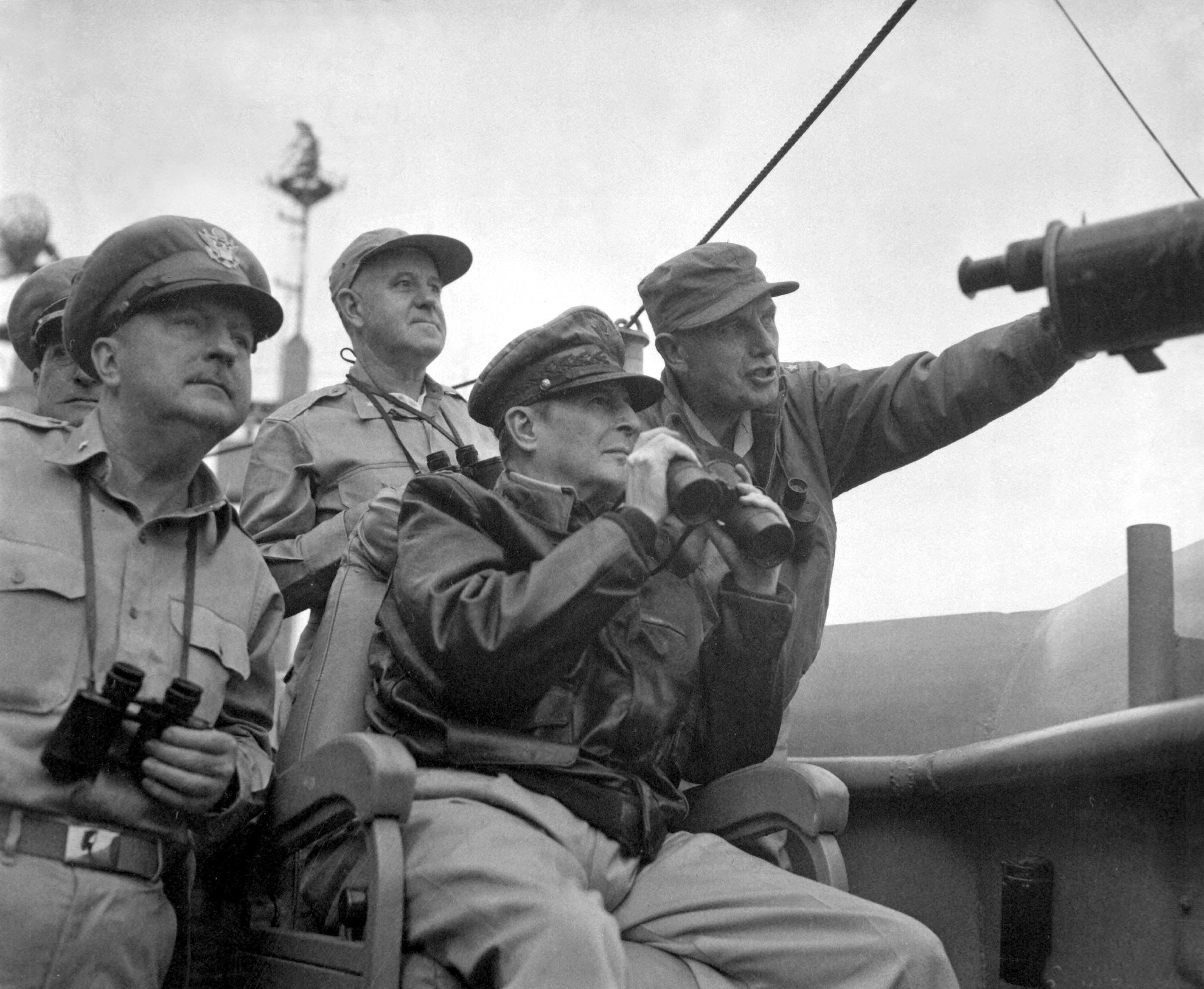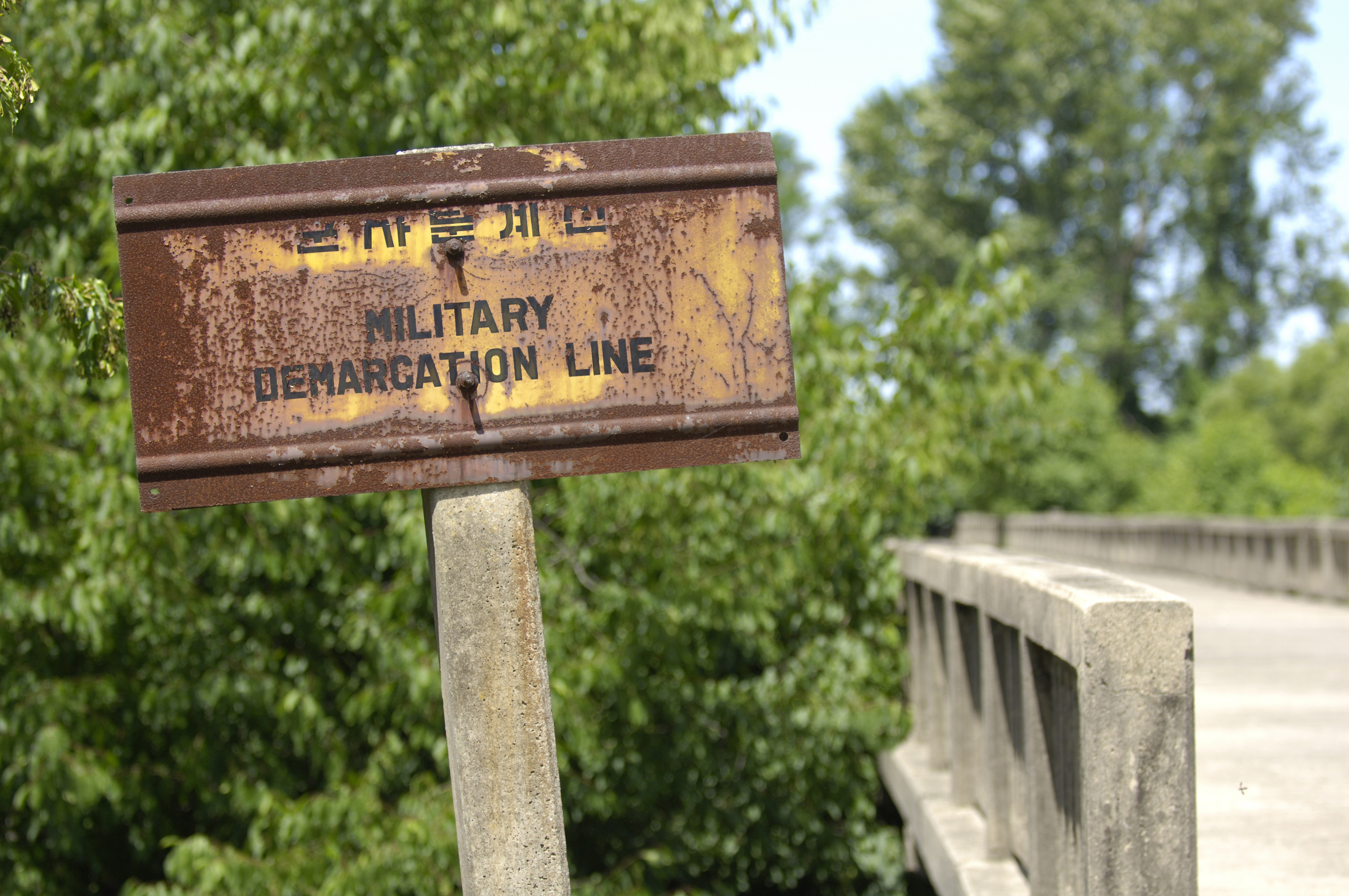Kim Il Sung (1912-1994) - Communist Leader of North Korea
Rhee Syngman- President of South Korea
Subsequently the UN sent peace-keeping missions under General Douglas MacArthur, supported by US President Harry Truman.

General Douglas MacArthur at the Inchon Offensive
In addition, Soviet Leader Josef Stalin had also pressured the Chinese communist leader, Mao Zedong into sending troops to North Korea to aid them, which he did as the UN peace-keeping troops advanced nearer to the Yalu River.
Other UN Security Council nations did send their troops as obliged by the UN Resolution 82, 83, 84.

"The Chinese cannot tolerate foreign invaders, and cannot just stand by and see imperialists invading our neighbours."
Chinese Propaganda Poster showing the cruelty of the Americans. On the left is a US plane dropping an atomic bomb on China, on the right is General MacArthur stabbing a baby and its mother.
What?
The entire Korean peninsula was split into two factions after the defeat of Japan in World War II. Following the cold war, both the Soviet Union and the USA supported governments of their respective ideologies, with Kim Il Sung backed by the Soviets, and Rhee Syngman backed by the Americans. However, both leaders being nationalists, wanted to unify Korea under their ideology, and following American military withdrawal from South Korea, the communists in North Korea decided to take action with fully aided military arms from the USSR.
When?
25th June 1950 to 27th July 1953
How?
On the dawn of June 25th 1950, North Korean troops crossed the 38th parallel, which marked the border between North and South Korea. Gradually, they fought all the way down south to Pusan, in southeast Korea, while killing civil servants and intellectuals. By September, South Korea was left with the vicinity of Pusan, which was 10% of the entire peninsular.
South Koreans withdrawing behind the 38th parallel
 However, following the passing of UN resolution 84, the UN sent peacekeeping troops under the US which launched the Inchon offensive, successfully chasing the North Koreans back up to the North over a week, and then continuing to fight upwards to the Yalu River, where the Chinese warned the Americans not to step on their toes.
However, following the passing of UN resolution 84, the UN sent peacekeeping troops under the US which launched the Inchon offensive, successfully chasing the North Koreans back up to the North over a week, and then continuing to fight upwards to the Yalu River, where the Chinese warned the Americans not to step on their toes.By November 1950, the UN troops had fought their way up to the Sino-Korean border at Yalu River, and looked destined to be able to invade the entire Korea. Just at this time, the Chinese, following pressure from USSR and for their self-protection, intervened in the war, and launched the Chinese Winter Offensive, in which they managed to fight the UN troops back to the South in just two months time.
From January 1951 till July 1953, both sides were fighting along the borders, with no side making advances. As such, on July 1953, the Chinese, North Koreans and the UN backed Americans signed the Armistice agreement, which caused a ceasefire on 27th July 1953. However, the South Koreans refused to sign it and as such, in actual fact, South Korea is still at war with the North, since they did not sign the armistice.
The different phases of the Korean War. Red represents the communist offensive, while green represents South Koreans and the UN forces
Why?
Both leaders were nationalists and wanted to unify Korea under their own ideology, and free from foreign rule, which they had been in for 35 years before the end of World War II. In addition, the leaders excluded the Koreans from post-war conferences deciding on the fate of Korea after the war. As such, many Koreans wanted to unify their country, but were unable to do so as the power was not with them, but with the superpowers. Following the end of the trusteeship in both North and South Korea, both the Soviets and Americans left Korea without unifying her and leaving her split. Furthermore, free elections were never held as there were now two separate states having different ideologies. In addition, the Soviets, unlike the Americans, left military aid there for Kim Il Sung to use in the case of a South Korea invasion to unify the country, which he ended up using to invade South Korea.
Results of Korean War
Casualties & Losses

War damage in Seoul
778053 from the UN and South Koreans
11187682 from the communists and North Koreans
Borders
Till today, Korea remains divided by a 248km by 4km demilitarized zone (DMZ) located approximately along the 38th parallel. However, within the DMZ, there is a Joint Security Area managed by both the North and South Koreans.
The demilitarized zone (DMZ)
The Korean War had also set the stage for further proxy wars between capitalists and communists in other parts of the world. One notable example would be the Vietnam War.
Personal reflections
The Korean War could be classified as a civil war, but yet, the US pressured the non-Soviet UN Security Council into sending peacekeeping troops to fight the communists. (Soviet Union boycotted all Security Council meetings after the Republic of China (Taiwan) instead of the People’s Republic of China was recognized) This went against the UN’s policy of non-interference, but they defended themselves with Article 42, Chapter VII of the United Nations Charter:
“Should the Security Council consider that measures provided for in Article 41 would be inadequate or have proved to be inadequate, it may take such action by air, sea, or land forces as may be necessary to maintain or restore international peace and security. Such action may include demonstrations, blockade, and other operations by air, sea, or land forces of Members of the United Nations.”
Furthermore, Soviet Union had not exerted their veto-rights as they were absent, but the United Nations Security Council Resolution 84 was passed anyways.
The Security Council,
Having determined that the armed attack on the Republic of Korea by forces from North Korea constitutes a breach of the peace,
Having recommended that Members of the United Nations furnish such assistance to the Republic of Korea as may be necessary to repel the armed attack and to restore international peace and security in the area,
1. Welcomes the prompt and vigorous support which Governments and peoples of the United Nations have given to its resolutions 82 and 83 of 25 and 27 June 1950 to assist the Republic of Korea in defending itself against armed attack and thus to restore international peace and security in the area;
2. Notes that members of the United Nations have transmitted to the United Nations offers of assistance for the Republic of Korea;
3. Recommends that all Members providing military forces and other assistance pursuant to the aforesaid Security Council resolutions make such forces and other assistance available to a unified command under the United States of America;
4. Requests the United States to designate the commander of such forces;
5. Authorizes the unified command at its discretion to use the United Nations flag in the course of operations against North Korean forces concurrently with the flags of the various nations participating;
6. Requests the United States to provide the Security Council with reports as appropriate on the course of action taken under the unified command.
By using the UN peacekeeping forces to combat communism in Korea, the Americans managed to “avoid” hitting head-on with the Soviets and risk a nuclear war. (However, it did come close later in the Cuban Missile Crisis)
Superpowers
Soviets
- Had the chance to try out their new military equipments, especially their air force (which was supplied to the Chinese)
- Still had North Korea as a communist ally without even directly engaging in battle.
- Showed many Third World countries that the Soviets were willing to aid them to unify their country under socialism and should as such choose the Soviet Union as their patron.
Americans
- Policy of containment worked. Communism did not spread to South Korea. Domino effect was slowed down, as accordance to NSC 68-http://en.wikisource.org/wiki/NSC-68
- Turkey, a neutral ally initially, joined NATO after the war.
- Consolidated their strong stand against communism in the Cold War, showed to nationalists fighting against communism in other countries that they had American backing.
Civilians
Many Koreans hate the idea of a split Korea, as they believe that they are from the same descent and should not be split by a mere border. Furthermore, this border, being set by the Soviets and Americans, made the Koreans more angered as they did not want to be under foreign rule once more, especially after 35 years under the Japanese. Yet, many families split by the DMZ were unable to see each other even after the war. This war, and border, destroyed many families, and many Koreans, whose family is in North Korea but themselves in the South or vice versa, were forced by circumstances to abandon their family in the other Korea.
However, in recent years, North and South Korea have slightly warmed up to each other and South Korea practices the “Sunshine Policy”, which tries to improve relations between the two Koreas. Despite so, North Korea has seemed to treat this policy without care as they continue to be isolationist to the world. Recently, split families were allowed to visit see each other on a fixed date at the Joint Security Area (JSA).
The border (Military Demarcation Line) in the JSA
Many Koreans have also expressed their support for the unification of Korea as to them, whether it is communism or capitalism, they would rather be unified than be split into two.

Post By Cheng Yuan Han



No comments:
Post a Comment